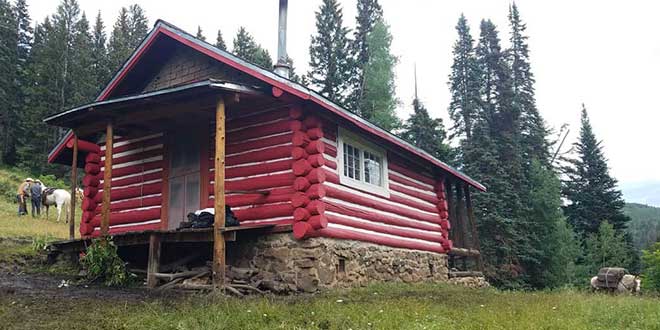Donning masks in the field or teleworking from home offices, Department biologists, conservation officers and education and information staffers found new ways to study and conserve our state’s fish and wildlife resources. Staffers got creative and found new ways to complete projects, or simply dreamed up innovative ways to promote outdoor education. Here are just a handful of our staff’s accomplishments:
Conservation officers take to the trail
In April and May, the COVID-19 pandemic was ramping up and so were conservation officers. Horses and mules were saddled, packs loaded with supplies and officers headed off into the Pecos Wilderness.
Just above the heart of Beatty’s Flats sits a cabin, rising above the headwaters of the Pecos River, the green meadows and just below tree line; the cabin has sat in this location since the 1950s. In the summer, officers use it as a base camp to check the health of, and bring salt to, the Rocky Mountain bighorn sheep and in the fall for checking high mountain hunters.
Loaded up at Jack’s Creek Trailhead, officers worked in pairs to carry supplies in to make repairs to the cabin. Traveling in the wilderness, especially in early spring, can be a challenge. Trees that were blown down over the winter block the trail. Officers were required to dismount from their horses and use hand saws to cut the trees, clearing the trail for the pack string to safely make its way to their destination.
Over several months, officers, along with their horses and mules, rode hundreds of miles, helped to clear numerous trails allowing access to the high country for recreationists, hikers, other horsemen and hunters. They repaired chinking and applied a fresh coat of paint to the cabin, updated plumbing inside the cabin to ensure the cabin will endure the harsh winters and pass on the legacy it has generated for over a hundred years. This cabin was named after George Beatty, who built the original cabin and was one of the earliest settlers of what we now know as the Pecos Wilderness. (Check out Beatty’s Cabin by Elliott S. Barker for more information on the wilderness and history of the cabin.)
Getting ready for a busy bear season
Throughout the spring and summer, the Field Operations team found many ways to continue the Department’s mission. Officers headed into the field to carry out their usual patrolling duties with masks, sanitizer and gloves; officers were even provided with additional pens to avoid sharing.
In addition to repairing Beatty’s cabin, conservation officers Corporal Jerry Pohl of the Albuquerque Supervisory District and Field Operations recruit Ryan Francis repaired the Department’s inoperable bear traps.
“What better way to socially distance and use our time well than by working on our equipment,” said Pohl, noting that the Law Enforcement repair shop recently purchased new equipment including a welder and torches.
“We’ve been using all of these tools to work on our bear traps and get them going. A bunch of traps needed minor and major fixes. Every single trap is now in good working condition. They’ll be effective when we set them out. The latches are working good.”
Repairing the traps themselves also saved the Department thousands of dollars in fixes that would have needed to be done by a contractor, Pohl noted.
Managing New Mexico’s hatcheries
Despite fishing restrictions, hundreds of thousands of fish housed at the Department’s six hatcheries still needed to find permanent homes in our state’s lakes, rivers and streams. “Fish don’t stop growing,” said Roddy Gallegos, assistant chief of fisheries with the Department. “You can put them on a rationed diet but only for a limited amount of time before you begin to compromise their health. As fish grow, biomass or densities within the culture environment increase. If fish are not stocked before densities get to high, fish will begin to die.”
In other words, too many fish, getting bigger and bigger, in one place. An increase in the population density of fish means higher mortalities and greater potential for disease outbreaks. To ensure the state’s salmon, trout, walleye and bass thrive, hatchery personnel inventoried the number of fry and fingerlings that needed to be removed and pulled together a list of waters that were open for fishing.
Hatcheries also continued receiving quarterly and monthly egg shipments. The “revolving fish culture system” continued, Gallegos explained. “You can’t just stop operations,” he said, noting that Red River hatchery receives 210,000 trout eggs per month, while Los Ojos receives 270,000 rainbow trout eggs every quarter. “You have eggs coming in and you have to get fish out. If a hatchery receives 200,000 eggs every month, you have to move out 200,000 fish every month, or biomass will explode.”
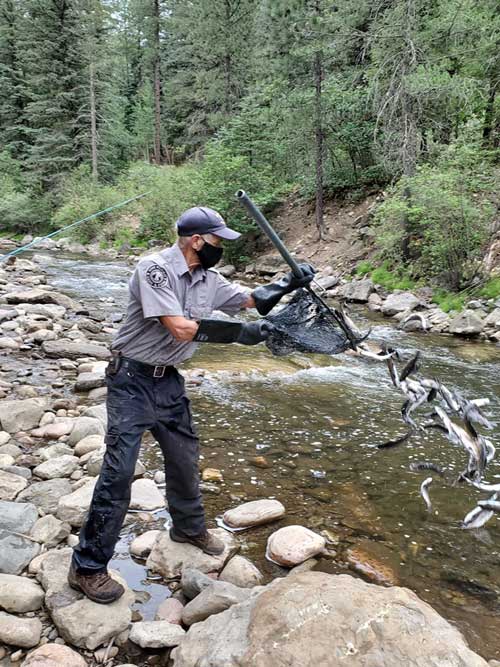
Gallegos also noted that hatcheries were—and still are— closed to the public. The Department limited access to hatcheries for non-hatchery staff such as biologists and administration. All outside individuals were required to request approval to access the hatcheries, and when these requests were granted, all visitors were required to abide by current health orders. “These measures were taken to protect staff and their families who reside on hatchery grounds,” he said.
Biologists tag rainbow trout at Eagle Nest Lake
Northern pike almost exclusively consume fish, and Eagle Nest Lake offers a plentiful menu including yellow perch, white sucker and fathead minnow. When given a choice, however, these fish may go after the fish most popular with anglers—rainbow trout.
In fact, said Jane Trujillo, coldwater fisheries biologist with the Department, biologists once found a full-sized rainbow trout measuring over 10 inches in the stomach contents of a northern pike.
“They’re very effective predators,” said Trujillo, adding biologists also found an 18-inch kokanee salmon in a northern pike stomach.
To gain a better understanding of the survival rate of rainbow trout at Eagle Nest Lake and the predatory role of northern pike, the Department this spring and summer tagged a total of 50,000 fingerlings (three-inch) and sub-catchable (six-inch) rainbow trout reared at Red River State Trout Hatchery and destined for the lake. Another 25,000 more were tagged in October. The fish will be marked with a microscopic wire tag in the snout, explained Trujillo. These tags, referred to as coded wire tags, “will allow us to later identify when the fish was stocked and at what size,” she noted.
“Results of this study will help us understand if fingerling or sub-catchable rainbow trout survival differs, how long it takes for a fish to reach a catchable size and fish condition post-stocking,” she said. “This information will help us to develop a stocking protocol that maximizes hatchery resources to benefit angler catch.”
Northern pike, an aggressive fish that can grow up to 3.5 feet in length, first discovered in Eagle Nest Lake in 2011, were most likely illegally introduced by anglers. Species introductions, such as this one, are illegal and can jeopardize existing fisheries in New Mexico. Remember – never move fish between bodies of water, noted Trujillo.
“We will also be conducting surveys at Eagle Nest Lake in spring, summer and fall for the next couple of years to gather data about seasonal changes to northern pike diet,” she said. Preliminary results show rainbow trout and kokanee salmon make up a substantial portion of northern pike diet in the lake.
New messaging boards warn motorists of large game animals
Since 2014, at least nine Rocky Mountain bighorn sheep have been killed by vehicles on New Mexico State Highway 38 between Questa and Red River. In 2016, a motorcyclist died in a collision with bighorn, with multiple sheep being killed or injured. In late winter/early spring, bighorn sheep move down from snow-covered higher elevations to forage on grasses sprouting early within the highway right-of-way and are also attracted to salt that is applied to the road as a de-icing agent.
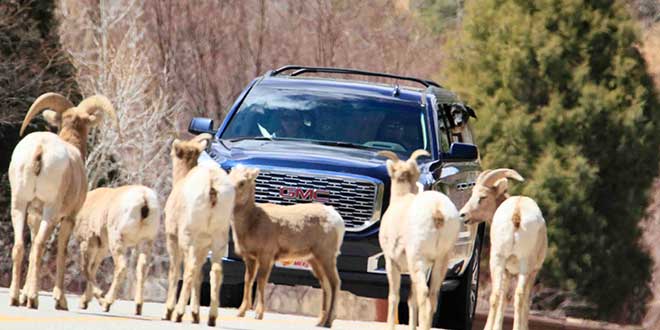
Based on research that demonstrates that variable messaging boards can reduce driver speeds and collisions with large game animals, in 2019 the Ecological and Environmental Planning Division purchased two of these signs to warn motorists at large game animal-vehicle collision hotspots.
In March 2020, these signboards were moved from a three-mile-long, high elk-vehicle collision corridor on U.S. Highway 70 at Bent (between Tularosa and Ruidoso) to New Mexico Highway 38 to warn motorists of bighorn sheep in the roadway. The signboards were retrieved in early June after bighorn had generally moved back up into the high country.
No sheep were known to have been involved with collisions during the period that the signboards were deployed. The Department will continue to deploy the signs to New Mexico Highway 38 in late winter/early spring to warn motorists to share the road with bighorn sheep!
Share with Wildlife, Audubon New Mexico offer activity books for kids
Last spring, Audubon New Mexico had plans to update their Outdoor Field Science curriculum to better align with the Public Education Department’s STEM Ready! Science Standards. The organization expected to offer both classroom and field-based interactions with students to implement the updated science curriculum, which focuses on New Mexico wildlife; their habitats, biology, and conservation; and scientific observation.
However, the restrictions and closures associated with COVID-19 required that they quickly modify these plans. Audubon New Mexico usually gives students from Santa Fe Public Schools an opportunity to explore and make observations of wildlife habitat elements and wildlife signs in the piñon-juniper woodland at Randall Davey Audubon Center in northern Santa Fe.
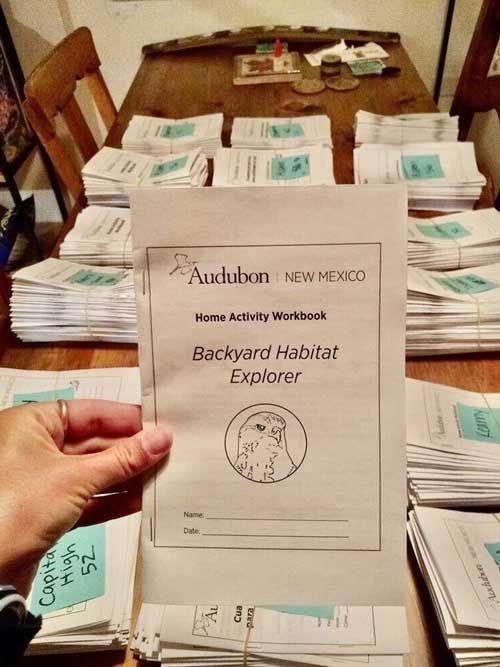
Instead of postponing the in-person program, Audubon New Mexico tapped the Department’s Share with Wildlife funds to produce workbooks that students could work through at home.
To ensure that students could still receive environmental education when they were sent home, Audubon New Mexico developed two workbooks in both English and Spanish. They worked with Santa Fe Public Schools to distribute them through food pickup sites, thereby targeting students who lack internet access at home. They also distributed the workbooks digitally to teachers who originally scheduled field trips to Randall Davey Audubon Center for spring 2020 but had to cancel them.
Students and teachers across the state now have access to two environmental education workbooks:
The Backyard Habitat Explorer workbook has students learn about the concept of habitat, identify habitat elements and animal sign in their backyard or neighborhood, map a habitat and consider what could be done to improve the habitat that they mapped for wildlife.
The Adapt to Survive! workbook has students learn about adaptations; write down what they see, smell, and hear outside their house, design a bird that could survive in New Mexico during the summer and complete an activity that helps them learn about how different bird beak shapes and sizes help birds better eat different kinds of foods.
To check out the workbooks, and for more educational resources, visit: https://nm.audubon.org/conservation/educational-resources
Department participates in surveys of New Mexico’s curlew population
The long-billed curlew, Numenius americanus, is a Species of Greatest Conservation Need in New Mexico, meaning that it warrants heightened attention in our state.
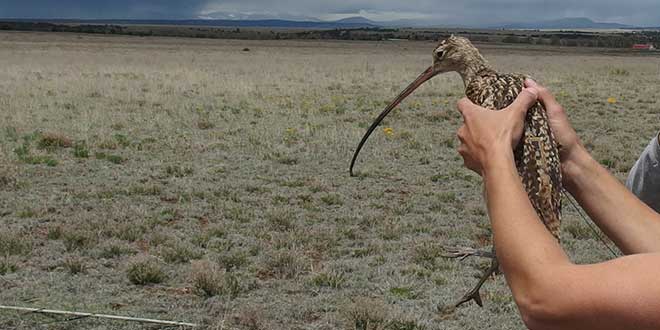
In an effort to fill critical information gaps, the Department joined the United States Fish and Wildlife Service, Boise State University’s Intermountain Bird Observatory, Rio Mora National Wildlife Refuge, Denver Zoological Foundation, Playa Lakes Joint Venture and other partners to collect data on curlews breeding in New Mexico.
Valuable data on migration routes and overwintering locations were collected from satellite transmitters deployed in 2019. After returning to New Mexico this spring, three of the curlews migrated back to the same non-breeding season locations used in Mexico last year. Additional transmitter deployment was planned for 2020, but capture efforts were not possible under COVID-19 social distancing requirements. Instead, standardized surveys were completed to increase knowledge of breeding season locations and habitat use; curlews were documented in Mora, San Miguel, Union, Harding, Roosevelt, Curry and Quay counties.
This project is part of a continent-wide migratory connectivity effort to determine conservation needs across this species’ annual cycle; please visit https://www.boisestate.edu/ibo/curlews/curlew-locations/.
Turkey capture and survey conducted in the Peloncillos
The Department continued its study of Gould’s turkeys this spring, trapping a total of nine in the Peloncillo Mountains in southwestern New Mexico and counting 224 during a survey conducted in partnership with the National Wild Turkey Foundation.

“Trapping was part of an ongoing effort to get Global Positioning Systems (GPS) out on birds for the last few years,” said Casey Cardinal, resident game bird biologist with the Department. The first transmitters were deployed in May 2018.
GPS locations taken during the day are used to investigate several components of turkey life, said Cardinal. “Turkeys feed and loaf much of the day, so we can identify habitats that may be used for these activities. The daytime locations also help us identify nest sites, and give us insights into what habitats hens use with their chicks after the nest hatches.
Additionally, the day time locations, Cardinal explained, help biologists identify some of the pathways that turkeys follow when they make long-distance movements.
The night locations are used to identify roost sites. “Since turkeys primarily rely on their eyesight to avoid predators, they are very vulnerable at night,” Cardinal said. “Roost trees are an important component of turkey habitat, as they provide turkeys a safe place to spend the night. Roost trees get the birds off the ground, away from many predators.”
The spring survey is an annual effort to get the minimum population numbers of Gould’s turkeys in the Peloncillo Mountains. Gould’s turkeys are listed as state threatened species. The Department passed a recovery plan in 2017, and biologists have been working on assessing the population status since that time.
Biologists capture bighorn at Rio Grande Gorge, detect disease in population
In February 2020, some animals in the Rio Grande Gorge population tested positive for the bacteria Mycoplasma ovipneumoniae (M. ovi). Bighorn sheep may initially acquire M. ovi and similar disease-causing organisms from contact with domestic sheep or goats and consequently spread those pathogens within or between bighorn sheep populations.
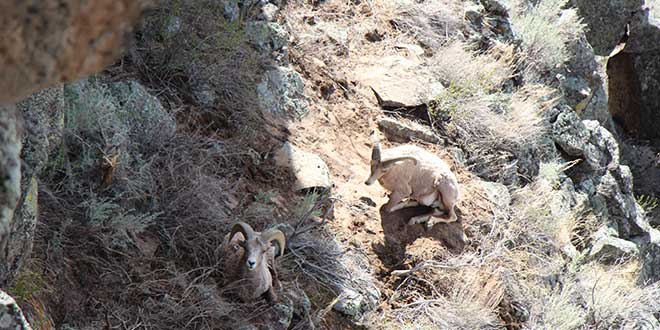
The bacteria’s presence is concerning because it has been identified as an important pathogen contributing to pneumonia in bighorn sheep. Pneumonia can be a serious disease in bighorn sheep that can result in all-age die-offs with detrimental impacts to the herds. Bighorn populations that have contracted M. ovi may remain healthy, or experience a pneumonia outbreak, with outcomes ranging from no mortalities to complete loss of the herd.
The Department has consequently increased monitoring of the Rio Grande Gorge bighorn population. In April and May, the Department, with assistance from Taos Pueblo, captured and collared 30 bighorn sheep using two-person ground darting teams (20 ewes and ten rams). Collared animals are being monitored and will provide valuable information regarding survival rates and lamb production in the context of M. ovi exposure. There have been no mortalities of collared sheep to this point.
Biologists detect virus in wild rabbits
Last March, the Department and the New Mexico Livestock Board reported that Rabbit Hemorrhagic Disease Virus type 2 (RHDV-2), a new variant of Rabbit Hemorrhagic Disease (RHDV), was detected for the first time in the state’s wild rabbit populations.
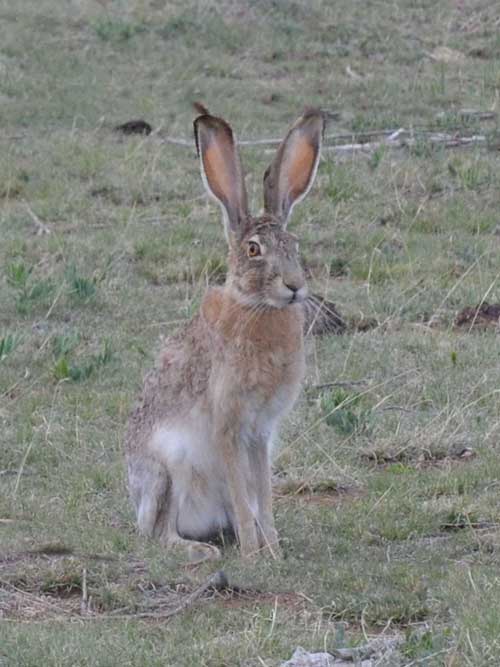
The Department began collecting carcasses for testing after reports of dead wild rabbits in early March. Mortalities in domestic rabbits also resulted in testing during this time.
Mortalities in wild populations have been reported from all of southern New Mexico, and areas surrounding Grants, Albuquerque, Santa Fe and Espanola.
RHDV-2 is expected to continue to spread and is transmitted among rabbits through direct contact, excrement, shared food sources and contaminated burrows. The disease, which has been found in both wild jackrabbit and cottontail populations as well as in domestic rabbit production facilities throughout the western United States, is highly contagious among rabbits; however, it is not known to be transmissible to humans or pets.
To be cautious, people should avoid handling dead rabbits without gloves, and pets should be kept from contact with rabbit carcasses they encounter. RHDV-2 is from a different viral family from the corona virus and is not related to COVID-19.
The Department has been testing wild rabbit carcasses for the virus since March; RHDV-2 was detected in the carcass of a black-tailed jackrabbit in Eddy County in April, said Dr. Kerry Mower, wildlife health specialist with the Department.
“Both jackrabbits and cottontails have been affected and are dying from this,” said Mower. “Since RHDV had never been confirmed in wild rabbits, it was thought that indigenous North American rabbits weren’t susceptible. With the discovery of this novel variant of RHDV, we have learned our assumption was incorrect.” The United States first saw cases of RHDV in the 1980s among domestic rabbits, most severely in extensive commercial rabbit facilities, he noted.
The Department asks the members of the public to report large numbers of dead wild rabbits to their local conservation officer or the Department Information Center at (888) 248-6866.
Reaching out from home offices
Despite travel restrictions and the cancellation of several of the Department’s popular hunter education events, the hunter education team still wanted to make sure students were prepared for their upcoming hunts.
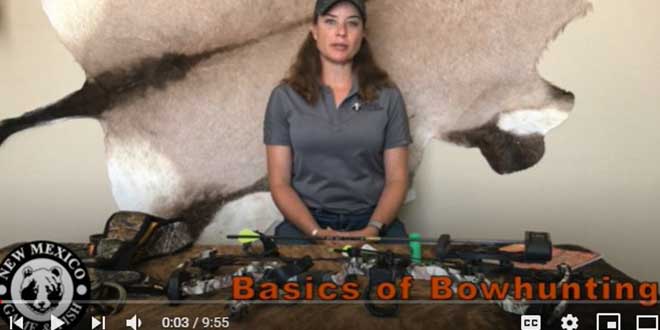
Hunter education program manager Jennifer Morgan teamed up with Ross Morgan, the Department’s northwest area public information officer, to produce fifteen instructional videos on topics including the basics of bowhunting and muzzleloading, zones of fire and safe firearm handling.
“While we’re always excited to get out into the field and work with our students, we knew we had to shift gears and find another way to help everyone prepare for hunts and meet their goals,” said Jennifer Morgan. “We hope everyone out there finds the videos helpful. We want to stay in touch with our students, and we hope to see everyone at future hunts and classes.”
Morgan noted that the videos have been utilized in the Department’s newly implemented virtual hunter education class and will continue to be made available to hunter education instructors when the program can resume in-person courses.
The video series can be found on the Department’s YouTube channel at https://www.youtube.com/user/NMGameandFish.
Knowing that outdoor activities were limited, the Department’s information team offered up fresh resources for kids and adults, from wildlife coloring sheets and lesson plans to extra e-newsletters featuring wild game and fish recipes and an online summer camp for kids. The Department also held conservation essay writing and art contests. Check out page 28 to read some of the winning essays.
The Department’s information center has remained open for calls from the public. Staff has been reduced to allow for safe COVID practices and information specialists have also been answering emails through the ispa@state.nm.us and on social media. Our staff is available Monday – Friday 8 a.m. – 5 p.m.; we are closed weekends and holidays.
“All of us in the Information Center very much appreciate the public with their understanding that we are experiencing longer hold and email response times,” said Lisa Brejcha, former information center supervisor.
Lastly, the Department has worked hard to ensure that business administration continues to run smoothly. Our fiscal section continues to develop purchase orders, pay bills and ensure that purchases go smoothly. While Department offices remained closed for extended periods, license sales are available through the online system and at licensing sales agents across the state.
Read more about the Department’s accomplishments during Covid-19 here (LINK TO COME).
 New Mexico Wildlife magazine Conserving New Mexico's Wildlife for Future Generations
New Mexico Wildlife magazine Conserving New Mexico's Wildlife for Future Generations
